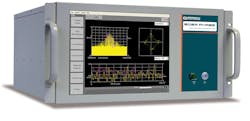PRODUCT FOCUS: OPTICAL SPECTRUM ANALYZERS: Understanding the latest features in optical spectrum analyzers
An optical spectrum analyzer (OSA) is a wavelength-selective optical power meter that measures (or frequency), tunable over a specified wavelength range somewhere between the ultraviolet and the infrared, depending on the application. The most common application of an OSA is characterizing optical components and testing optical signals in telecommunication networks. These “can’t-do-without” instruments are expensive, ranging up to $35,000, so due diligence is crucial before you buy. We consulted with various manufacturers of OSAs to help break down what to consider when selecting one.
Optical spectrum analyzers are similar to wavelength meters in that they produce a spectrum of intensity versus wavelength, but each has a slightly different specialty. While wavelength meters pinpoint the wavelength of a laser to an extremely high accuracy, optical spectrum analyzers measure both wavelength and of a laser at a high accuracy, often across a much wider dynamic range of wavelengths. This makes OSAs useful for analyzing transmitted signals—in particular, for discriminating a desired signal from unwanted noise, known as the optical signal-to-noise ratio (OSNR).
In dense wavelength division multiplexing (DWDM) systems, OSAs are the key instruments for testing (channel) power levels, wavelength, and OSNR over a specified wavelength range. Traditionally, the wavelength range of an OSA covers the transmission band of single-mode optical fibers from 1250 to 1650 nm used for telecom WDM applications, says Wolfgang Moench, product line manager at JDSU Fiberoptics Division (Germantown, MD).
Optical spectrum analyzers typically use either direct spectral measurement or fast-Fourier transform (FFT)-based measurement. According to Daniel Gariépy, system engineer at EXFO (Quebec City, QC, Canada), a direct-measurement OSA usually incorporates a monochromator (an input slit with a tunable filter or diffraction grating coupled with a high-resolution angular control system and an output slit) coupled to an optical power meter (a high-dynamic-range optoelectronic conversion circuit, followed by signal-processing electronics and software). Diffraction-grating-based OSA configurations include Litman-Metcalf or Littrow, which offer a wide spectral tuning range and high angular spectral discrimination with the drawback of high polarization-dependent transmission. Polarization management is one area that differentiates OSA manufacturers via proprietary innovations, says Gariépy, such as polarization rotation before the second pass, and polarization diversity detection.
An OSA that incorporates fast-Fourier transform (FFT)-based measurement is often called a multiwavelength meter. Multiwavelength meters can achieve results similar to that of OSAs with a strong emphasis on high-performance wavelength certainty at the expense of uncertainties in power measurement, such as peak power and noise floor in the presence of multiple channels, or polarization-dependent power. Bristol Instruments (Victor, NY), specializes in such a multiwavelength meter, which incorporates a scanning Michelson interferometer with the wavelength axis calibrated to ±0.0001 nm. Says Brian Samoriski, president of Bristol, “A typical direct-measurement OSA has a wavelength axis calibrated to measure absolute wavelength to about ±0.01 nm. An FFT-based OSA typically measures relative power. So the user must decide which axis is more important, the intensity axis or the wavelength axis.” These Michelson interferometer-based OSAs are limited to a dynamic range akin to 30 or 40 dB. Bristol Instruments’ 621B-MIR and Agilent’s 86120B multiwavelength meter are examples of this type of device.
Another type of OSA is the heterodyne OSA, which uses inverse Fourier transforms to achieve very high resolution bandwidth (RBW) for a limited wavelength range of 1528 to 1565 nm. Launched at OFC/NFOEC 2010, the BOSA Phase High-Resolution Complex OSA from Aragon Photonics (Zaragoza, Spain) offers 0.08 pm of resolution simultaneously with an extended dynamic range up to 80 dB. The BOSA Phase returns real-time measurements of wavelength, power, amplitude, and relative phase between components of discrete spectra at a wavelength accuracy of ±2 pm at 1550 nm. The BOSA Phase is designed for use in developing 40G/100G networks (see Fig. 1).
The company line
Each company in the OSA market focuses on different application areas and a combination of field-based or lab/benchtop systems. Anritsu (Richardson TX) offers two types of direct-spectral measurement OSAs: diffraction-grating-based with a slit, such as the new benchtop MS9740A for lab use; and diffraction-grating-based with an optical photodiode array with a special bandpass filter, such as the portable CMA5000 Multilayer Test Platform for field use (see Fig. 2, left).EXFO focuses on field-deployable OSAs for both legacy and next-generation networks. Currently, its next-gen OSAs target reconfigurable optical add-drop multiplexers (ROADM) and 40 Gbit/s networks applications, which require a more complex OSNR measurement.
Until very recently, says Francis Audet, senior product line manager at EXFO, OSAs measured the peak power of a transmission signal at any given wavelength, and noise was measured on either side of the signal. For those legacy networking applications, the key specifications of OSAs were therefore the RBW of the unit, and its optical rejection ratio (ORR) at high signal density, each of which relate to the ability to discriminate a signal from an adjacent one and to make accurate and sharp noise measurements. “For next-generation networks like ROADM and 40 Gbit/s, noise is measured within optical signals rather than beside them,” says Audet, “so a simple noise measurement is no longer valid.”
For OSAs used in next-gen applications, this key specification is in-band OSNR accuracy under several conditions: high or low OSNR, presence of PMD, and at different power levels. “Yet a lot of legacy applications (2.5G, 10G, CWDM) remain for which OSNR is still a key parameter,” says Audet. Because OSNR includes an accurate power measurement for both legacy and next-gen applications, specifications such as power accuracy and polarization-dependent loss (PDL) have become more important. EXFO’s field-ready FTB-5240S OSA addresses those needs (see Fig. 2, right).
JDSU offers diffraction-grating-based units for both field and benchtop use, with a broad range of performance and price points. Early in 2010, JDSU announced its new OSA for next-gen networks: the OSA 500 and ROADM OSA 500R high-performance modules for the T-BERD/MTS 8000 platform. The OSA 500R is the second iteration of OSAs to provide in-band OSNR measurement, dedicated to high-speed overlapping DWDM spectra and ROADM networks of 40/100 Gbit/s transmission at 50 GHz channel spacing. On the low-performance side, if all you need is to check whether a signal is getting through, basic channel checkers for CWDM and DWDM applications (such as JDSU’s OCC-55 and -56, starting at $6000) come in a handheld format and provide the power level and wavelength of the transmitted channels. The new COSA-4055 optical spectrum analyzer (OSA) for the T-BERD/MTS-4000 platform is designed for CWDM testing only, at a fraction of the OSA price (see Fig. 3, left).Feeling hot, hot, hot
The hottest area of OSAs right now involves the expansion to wavelengths outside of the traditional telecommunications bands. A greater dynamic range of wavelength is useful in gas sensing, laser metrology, cell florescence, laser projection, and laser cutting, marking, and printing.
Yokogawa Corp. of America (Newnan, GA) offers three expanded-wavelength-range benchtop (read: high-performance) models covering wavelengths from 350 to 2400 nm. The benchtop AQ6373, covers the visible-wavelength range between 350 and 1200 nm, useful in the development and manufacturing of short-wavelength lasers, passive devices, and LEDs in the biomedical, material processing, consumer products, and telecommunications markets (see Fig. 3, right). This is the third in the AC6370 series; the AQ6370B covers the standard telecom range from 600 to 1700 nm, and the AQ6375 is for long wavelengths from 1200 to 2400 nm.
Key specs?
Most manufacturers concur that the most important specifications for an OSA are the accuracy of the wavelength and power measurements. In DWDM networks, OSNR is of critical importance. In DWDM applications, says Hiroshi Goto, optical product specialist at Anritsu (Richardson, TX), each wavelength (frequency) needs to be within 1/10 of the grid spacing, so a high-accuracy wavelength measurement is crucial. Look for high-end grating-based OSAs for DWDM apps to provide wavelength measurements to within ±0.02 nm, and power-level accuracy to within ±0.5 dB including the PDL error, says Goto.
If you need a single OSA to measure both CWDM and DWDM networks, there are a few special requirements, says JDSU’s Moench. First, it must cover the wavelength range for both CWDM and DWDM (approximately 1250 to 1650 nm). Second, says Lietaert, the optical resolution needs to be in the range of <0.1 nm for the standard DWDM channel spacing of 50 GHz. Third, to measure the OSNR (20 to 25 dB at the receiver site) in a DWDM system, the filter characteristic of the OSA requires an ORR of >30 to 35 dB at 0.2 nm from the channel peak.
According to Moench, for the channel wavelength to meet ITU-T specifications, the absolute accuracy of the OSA should be approximately two times better than the limit of the system being measured. For a 50 GHz DWDM system, the max channel offset would be 10%, which is 5 GHz or 0.04 nm. So the absolute wavelength accuracy of the OSA might be in the range of ±0.02 nm.
Sweep speed is an important spec that relates to speed of test, but different manufacturers define sweep speed conditions differently. “The sweep speed on an OSA is dependent on the setup, span, resolution, sensitivity mode, and average times per sample,” says Larry Walsh, application engineer at Yokogawa. “To do an apples-to-apples comparison, the settings on the different OSAs must be compatible. Request demo units to compare OSAs for your particular application.”
Another feature to look for is a high-speed LAN interface to reduce hardware cost and allow real-time remote access to the unit on your factory floor from anywhere in the world, says Kwok at Yokogawa. Other important features are USB ports for memory-stick file transfer and a mouse-driven graphical-user interface (GUI).
Editor’s note: The “Product Focus” series is intended to provide a broad overview of the product types discussed. Laser Focus World does not endorse or recommend any of the products mentioned in this article.

Valerie Coffey-Rosich | Contributing Editor
Valerie Coffey-Rosich is a freelance science and technology writer and editor and a contributing editor for Laser Focus World; she previously served as an Associate Technical Editor (2000-2003) and a Senior Technical Editor (2007-2008) for Laser Focus World.
Valerie holds a BS in physics from the University of Nevada, Reno, and an MA in astronomy from Boston University. She specializes in editing and writing about optics, photonics, astronomy, and physics in academic, reference, and business-to-business publications. In addition to Laser Focus World, her work has appeared online and in print for clients such as the American Institute of Physics, American Heritage Dictionary, BioPhotonics, Encyclopedia Britannica, EuroPhotonics, the Optical Society of America, Photonics Focus, Photonics Spectra, Sky & Telescope, and many others. She is based in Palm Springs, California.


